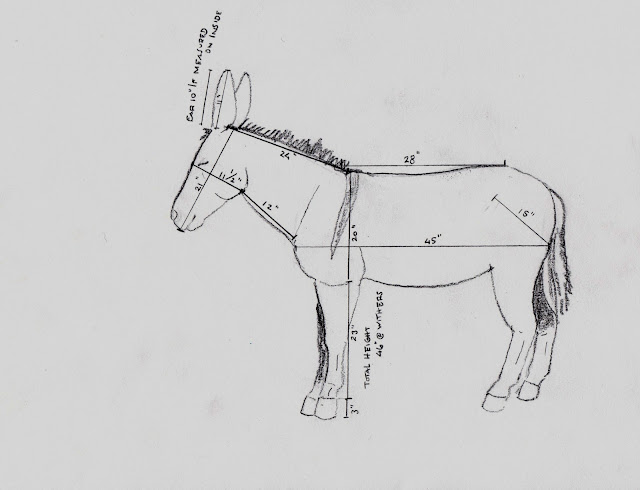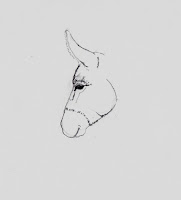As I move ungracefully and reluctantly toward my dotage and the years of being an "older rider," I've long realized gravity is not my friend; that the ground is harder now, and hay bales heavier; that I don't bounce particularly well, and that body parts don't heal with either the certainty or swiftness they once did. A while back, thinking ahead to the days when I can no longer hop on a horse or mule, I decided to do more harness work with my crew so that if I can't throw a foot in a stirrup, I can still throw my aging posterior onto a cart bench. Besides, I've always enjoyed harness horses and hitches and wagons and such. With all that in mind, I've been working Odelia the donkey in harness more, and a few months back got her a beautiful easy-entry Amish cart.
Odelia's been doing so well, too. She's a happy donkey, very eager to please and compliant, and she is thrilled when she sees me coming with the halter. She's not energetic, and isn't leaning on the tugs in a hurry to move out. That's fine with me. I just want a solid, quiet, amiable little buddy to pull the new cart around the ranch. I've chronicled parts of her harness-career saga in previous blogposts here.
On Thursday afternoon, two days ago, I hitched her up and drove her off the property for the first time. Not far - just to the neighbor's driveway, where we were able to make a turnaround. I drove her back to the barn, did a lap around the barn area, and then headed back along the same route to do precisely the same thing. In the meantime, the curious chupacabras turned out in the pasture - two mares and a gelding - had made their way to the fence line along the driveway to see what was going on. As soon as we approached them I knew there was going to be drama. I stopped Odelia and let her stand for a minute so they could get a good look. Horses that are unaccustomed to horse-drawn vehicle use are typically pretty spooky of them, and I knew - despite the many laps around the barn area I've done in recent weeks with Odelia and the cart - that there was a good chance those three knuckleheads would spook and bolt. Odelia, though, has been a solid little donkey.
As soon as I started her back into a walk, it was obvious there was going to be a train wreck. The three horses spun and bolted. Odelia, despite having her blinkers on, bolted along with them. She was headed directly for a scrubby mesquite. I overcorrected and pulled left. Odelia is a responsive donkey with a soft mouth, and she spun around to the left as fast as her little donkey legs would go. She went left, I went right - right over the top rail of the cart and hard onto the gravel road. My right hip hit first, followed promptly by right elbow and right side of my head, as my left hand extended out to try to break my fall. I slid on said hip, elbow and head until coming to rest. It wasn't a graceful Trea Turner slide. It was a hard, painful, gravity-really-sucks slide, and as soon as I stopped I was aware of poor, frightened Odelia bucking repeatedly and finally trotting face first into the field wire fence as I vainly hollered, "Whoa, now!" And then, just seconds after it all unfolded, she came to a stop and stood quietly at the wire fence.
I was hurt. I started to get shocky and fought it as I have on so many prior occasions: "Don't pass out. Don't pass out. Breathe!" And in what has become all-too routine I took inventory of my body parts: Right hip, agony. Right elbow, agony. Head, OWWW! I touched my elbow with my gravel-filled gloved hand and saw blood on my glove. I tried to stand; my hip tried to collapse. I made it to Odelia's side and just leaned across her back, talking to her and trying to beat the persistent shock from causing me to pass out.
It was obvious I wouldn't be able to walk the 1/4 mile to the house, so I crawled back into the cart and asked Odelia to please take care of me and safely get me to the barn. She did. She was once again quiet, willing, sweet Odelia, and we made it to the barn. The entire distance the world around me turned bright, radiant yellow - the shock again trying to force me to pass out, while I continued willing myself to proceed - and I could barely see through the bright yellow surroundings. At the barn, I was able to get out of the cart, unhitch Odelia from the cart, remove her harness, and put her away ... and then I faced the long, arduous trek to the house. At each step, my right hip collapsed underneath me.
I took a more detailed inventory. Elbow clearly needed sutures and was bleeding as well as leaking a yellowish fluid ... synovial fluid, as it turned out. I could move it, but with great pain. Hip: so swollen the swelling was visible even with my jeans on, terribly painful especially with weight bearing, but good range of motion, but that weird collapsing feeling when I took a step. Knees: Both scraped and the right one puffy. Head: Road rash on my upper right side, bruise and a large swollen area and road rash on the upper forehead even past the hairline. It hurt to touch, hurt when I didn't touch, and hurt in the mandibular area when I opened my mouth. Everything else, pretty darned good.
I hurt too much to try to go to the ER 45 miles away, so I soaked in a bathtub full of epsom salts, cleaned and debrided the elbow wound the best I could and dressed it with triple antibiotic and silver sulfadene and wrapped it with padding, and afterward I sat with ice packs on various body parts. Due to my kidney disease, taking anything more than a Tylenol was verboten. Throughout the night I was a case study of abject misery, the elbow throbbing as well as stinging like I'd thrown salt on it.
First thing the next morning, after having the husband person drive me to the barn so I could treat a mare's injured eye, I cleaned up and shampooed the gravel out of my hair and had him tote me to the Benson hospital. There, a very kind and thorough doctor expressed his concern about a possible hairline fracture to the hip, infection to the elbow laceration that it was now too late to suture, and the fact my ears felt filled up (it felt like I'd been at higher elevation). By then, there was a line directly across my torso right below my breasts that was tight and tender. Multiple X-rays and CT scans, and a solid exam later, he gave me the amazing news that I hadn't broken anything. The hip: ligament and soft tissue damage galore, and a likely deep bruise / blood pocket. The elbow: Bruising, ligament damage, and that darned synovial fluid leak. The head: Hard enough to resist any injury beyond road rash and a good knot. As the doctor put it, I dodged a big one.
So here I am, enjoying the irony that I pursue an equine activity intended to be a safe alternative to riding, only to be laid up for a while after all. The fact harness work is intrinsically dangerous is not new to me; I've spent thousands of hours reading through old papers and death records while researching for my western history books, and have read countless accounts of "local man killed in wagon wreck" or "child killed in buggy accident." The incident confirms my awareness of how hard the ground is, and how unfriendly gravity is. Horse-drawn vehicles are far more dangerous than the horseless carriage; there are no seat belts, or windows to keep you from being ejected, or airbags. The horsepower behind them is subject to flights of fear or fancy that can easily lead to runaway situations, and unlike being in the saddle, gripping with your knees and clenched buttocks isn't going to keep you from flying.
 |
| The scene of the crime. You can see the tree we were headed to at right, alongside yaw marks and scalp scuff. |
Odelia, by the way, is just fine, and to my relief has no injuries at all. My beautiful new cart is also, from what I could tell through my shocky eyes yesterday, also intact. I expect my hip will give me problems for some time, although I'm walking a bit better today and was able to drive to town to pick up the muscle relaxant the doctor prescribed. With its help maybe I'll get a bit more sleep tonight rather than waking up at 0300 with pain in the elbow. By the way - that elbow now matches the other one, which required six stitches when a horse fell with me on pavement many years ago.
Life isn't without risk, and I expect in a few weeks to be driving Odelia around again. All of us in the horse world know it's not if but when and how many times an injury will occur. We make choices as to how much risk we'll take, and how much safety we will prioritize, but there's no way to make certain activities entirely safe, just to make them degrees of safer. I've had the thrilling joys of hang gliding, pursuit driving, twenty years of police work, distance cycling, backpacking alone, and a lifetime with horses. I've endured a lot of injuries along the way - but that adrenaline is addictive stuff, and horses more addictive still. So foolhardy as it may be, I will continue to enjoy my horses (between injuries, of course). It is my decision.
 |
| The deep scraping is where my hand or elbow slid along the ground. It doesn't show in the photo but there was a distinct, pathetic hand print in the gravel. Good thing I had gloves one! |
 |
| A knot on the forehead and above the brow and some scalp scuff, but otherwise intact! |
 |
| Yes, the elbow could've used a couple of stitches. |





























